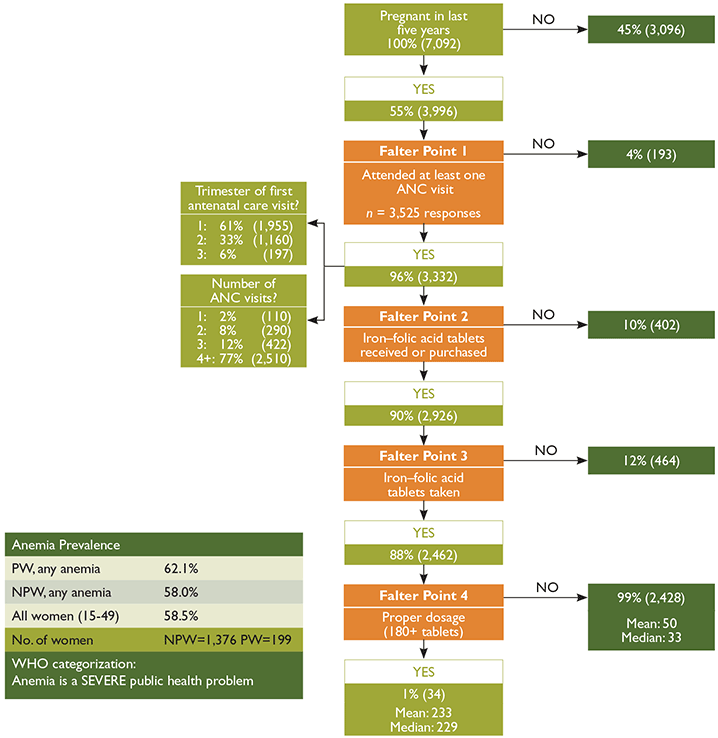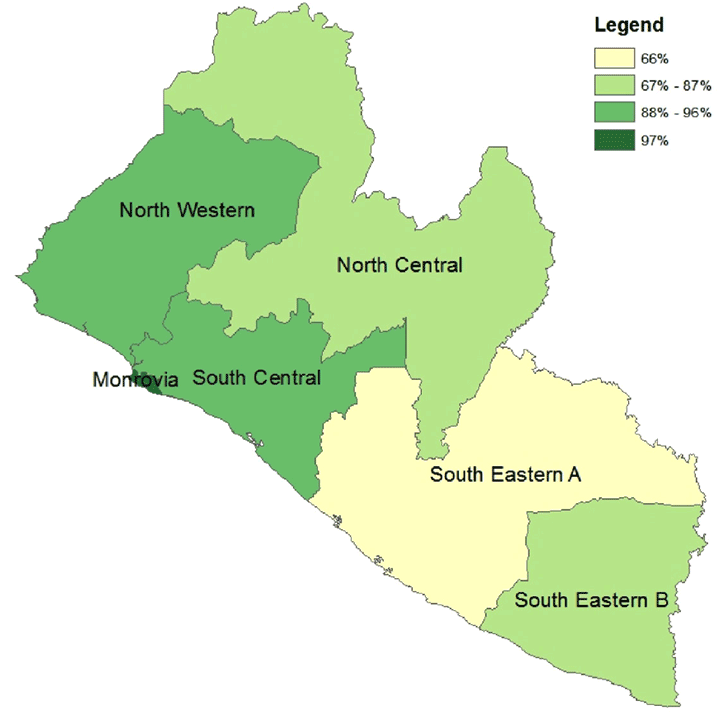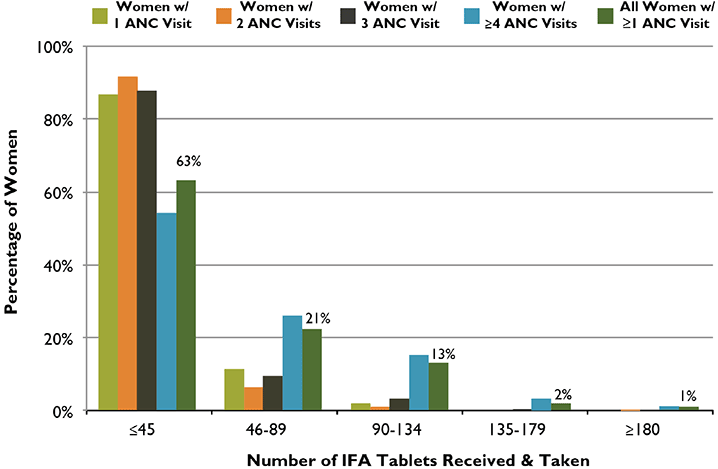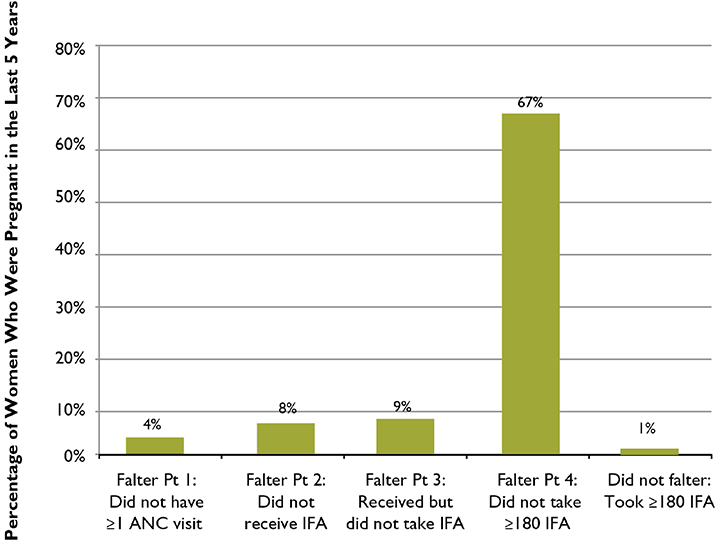Overview of the Global Anemia Problem, Including Iron Deficiency Anemia
The World Health Organization (WHO) defines anemia among women of childbearing age as the condition of having a hemoglobin concentration of < 12.0 g/dL at sea level; among pregnant women it is defined as < 11.0 g/dL. The hemoglobin concentration cutoff level that defines anemia varies by age, gender, physiological status, smoking status, and the altitude at which the assessed population lives.
The primary cause of anemia is iron deficiency, a condition caused by inadequate intake or low absorption of iron, the increased demands of repeated pregnancies—particularly if not well spaced (e.g., fewer than 36 months between pregnancies)—and loss of iron through menstruation. Other causes of anemia include vitamin deficiencies (such as a deficiency of folic acid or vitamin A), genetic disorders, malaria, parasitic infections, HIV, tuberculosis, common infections, and other inflammatory conditions. While iron deficiency anemia (IDA) accounts for about one-half of all anemia cases, it often coexists with these other causes.
Iron deficiency anemia is most common during pregnancy and in infancy, when physiological iron requirements are the highest and the amount of iron absorbed from the diet is not sufficient to meet many individuals’ requirements (Stoltzfus and Dreyfuss 1998). Anemia’s effects include increased risk of premature delivery, increased risk of maternal and child mortality, negative impacts on the cognitive and physical development of children, and reduced physical stamina and productivity of people of all ages (Horton and Ross 2003). Globally, IDA annually contributes to over 100,000 maternal deaths (22 percent of all maternal deaths) and over 600,000 perinatal deaths (Stoltzfus, Mullany, and Black 2004). Key anemia control interventions include promoting a diversified diet, iron-folic acid (IFA) supplementation during pregnancy, iron fortification of staple foods, prevention and treatment of malaria, use of insecticide-treated bed nets, helminth prevention and control, delayed cord clamping, and increased birth spacing.
Maternal Anemia in Liberia
According to the most recent available data—now more than a decade old—the prevalence rate of anemia among pregnant women in Liberia is 62 percent, making it a severe public health problem as defined by WHO standards1 (Mulder-Sibanda et al. 1999). Although the prevalence remains high, rates of maternal anemia had dropped 16 percentage points over the previous 10 years (Jackson and Jackson 1987). Previous research has indicated that food taboos during pregnancy that restrict the consumption of iron-rich meat and animal products; hookworms; the underutilization of ANC; and cultural beliefs that restrict increases in food portions and decreased workloads until after birth contributed to the exceptionally high maternal anemia rates in Liberia (Jackson and Jackson 1987).
Falter Points in Women's Consumption of Iron-Folic Acid During Pregnancy
WHO recommends that all pregnant women receive a standard dose of 30–60 mg iron and 400 μg folic acid beginning as soon as possible during gestation (WHO 2012). Ideally, women should receive iron-containing supplements no later than the first trimester of pregnancy, which means ideally taking 180 tablets before delivery. It is important to note, that many countries aim for women to receive 90 or more tablets during pregnancy.
Figure 1 shows a decision-tree analysis of how well the Liberian antenatal care (ANC) system distributes IFA, and identifies four potential points at which the system might falter (highlighted in orange). The figure tracks the number and percentage of women who obtained ANC, those who subsequently received and consumed at least one IFA tablet, and those who consumed the ideal minimum number of tablets.2 All data are based on Liberia Demographic and Health Survey (LDHS) questions asked of women who were in permanent unions and had been pregnant in the five years prior to being interviewed3 (LISGIS et al. 2008).
Figure 1. Analysis of Falter Points Related to Distribution and Consumption of IFA through Liberia’s ANC Program in 2007, Women of Reproductive Age (15–49 Years) n = 7,092

Main Conclusions: ANC coverage in Liberia is high, providing an outstanding platform for IFA distribution. Among women who were pregnant in the last five years, had at least one ANC visit, and took at least one IFA tablet, only one percent received and took the ideal minimum number of tablets. Falter Point 4 is the most critical shortcoming. Supply and demand factors are both likely constraints.
Anemia hemoglobin cutoffs: PW Hb <11.0 g/dl; NPW Hb<12.0 g/dl
Non-responses, no data (NR/ND) were recoded to “No” for “”At least one ANC visit?” “IFA tablets received?” and “IFA tablets taken?” and to zero for “Number of tablets taken?”.
Anemia prevalence data are provided as a reference point, signaling the general order of magnitude of the anemia public health problem. The ANC utilization data is based on self-reported data of women 15–49 years in permanent unions and pertains to their last pregnancy in the last five years prior to the DHS.
Source: Calculations are from the Liberia Demographic and Health Survey (2007). Anemia levels from WHO VMNIS Reference 1242, 1999.
Many supply-side aspects—including both adequacy of IFA tablet supplies and technical knowledge and practices of ANC providers—need to be considered when assessing how well an ANC program delivers IFA. In addition, as Falter Point 4 in Figure 1 clearly shows, the provision of IFA tablets to a pregnant woman is a necessary but not sufficient condition for the woman to consume the tablets, particularly at the ideal minimum level. Thus, demand-side factors also play a critical role in determining the coverage and effectiveness of a program. These include whether or not women seek ANC and the timing and number of visits, as well as the extent to which women are aware of the significance of anemia and IFA, ask for IFA tablets, and comply with the IFA regimen.
Understanding the relative significance of each falter point makes it possible to prioritize them for more in-depth analysis, providing a first step in an evidence-based approach to systematically improving the program. The DHS does not collect information on the number of IFA tablets received by women. In the case of Falter Point 4, this lack of data creates ambiguities that make it impossible to fully understand whether shortcomings of the system relate primarily to supply- or demand-side factors. Despite this limitation, the decisiontree analysis presented in Figure 1 still enables prioritizing the falter points for more in-depth analysis and action at the national, district, and health center levels.
Analysis of Falter Points
Falter Point 1:
Did not attend at least one ANC visit
Only four percent of women did not have at least one ANC visit.
ANC’s high coverage gives it great potential as a vehicle for providing IFA.
Falter Point 2:
Did not receive or purchase at least one IFA tablet
Of the women who had at least one ANC visit, 10 percent did not receive or purchase any IFA tablets.
This supply-side constraint is relatively small and may be due to various system/supply-side performance shortcomings, which could reflect: (1) inadequate supply (e.g., stockouts); (2) inadequate provider knowledge; or (3) inadequate provider practices, whereby IFA was not provided.
Unfortunately, the LDHS does not report the source(s) of the IFA tablets women received or purchased, and a small percentage of women attending ANC get IFA tablets from a different source. While only one percent of Liberian women who received or purchased IFA did not have any ANC visits (not shown), we cannot ascertain whether or not those who received ANC obtained their IFA from their ANC provider. However, women who attend ANC may be more likely to be aware of, to value, and also to also take IFA tablets, regardless of where they obtain them. Thus, we would expect a high correlation between the number of women who had at least one ANC visit and those who received or purchased IFA, which is consistent with the data. Women who had one or more ANC visits and who did not receive any IFA represent a missed opportunity to reduce the risk of anemia among a high-risk population.
Falter Point 3:
Did not take at least one IFA tablet
Of the women who received IFA, 12 percent did not consume any tablets.
This demand-side constraint is relatively small and may be due to women not understanding the significance of anemia and/or the significance of IFA. This misunderstanding may reflect: (1) inadequate provider counseling and follow-up; (2) women’s beliefs about actual or possible side effects; or (3) sociocultural factors. As Figure 2 shows, this is the second-most important falter point among all women in Liberia and among the highest rates observed among all the assessed countries.
Falter Point 4:
Did not consume 180 or more IFA tablets
Of the women who received and took IFA, 99 percent did not consume the ideal minimum of 180 IFA tablets.
This constraint results from a combination of supplyand/ or demand-side factors. Figure 1 suggests two situations that may contribute to this falter point: 39 percent of women who received ANC began their care after the first trimester, and the 22 percent who had fewer than WHO’s recommended four ANC visits during their last pregnancy may have started their ANC too late or may not have had enough visits to receive 180 tablets (given IFA distribution protocols). Both of these scenarios are likely contributors, but further research is needed to establish their relative importance, as well as the significance of other possible causes.
Globally, research has found that the following situations often contribute to Falter Point 4: (1) providers do not have access to adequate supply; (2) women do not receive adequate tablets because they have little access to care, start ANC late, or do not have enough ANC visits, making it difficult to obtain 180 tablets (given IFA distribution protocols); (3) providers do not provide adequate counseling or follow-up; (4) women do not adhere to the regimen, which may be due to difficulty in remembering to take the tablets daily, not knowing all the tablets are necessary, fear of having a big baby, side effects, or tablet-related issues (taste, size, color, coating, packaging/storage problem). Further research is needed to determine the underlying factors contributing to this falter point in Liberia.
Figure 2. Percentage of Women Who Had at Least One ANC Visit and Received at Least One IFA Tablet by Region, Liberia, 2007

Analysis by Sociodemographic Variables and Trends over Time
LDHS data from 2007 present encouraging ANC and IFA coverage rates for Liberia. Ninety-six percent of women have at least one ANC visit, with 87 percent of women receiving IFA tablets. As seen in Table 1, however, variations in ANC and IFA coverage are apparent across regions, especially with regard to IFA. The lowest coverage rates are observed in the South Eastern A region, with its having the lowest IFA coverage (61 percent took at least one tablet) and lowest ANC coverage (87 percent). Marked differences in IFA coverage also exist between urban and rural women. Pregnant women residing in rural areas are 13 percent less likely to receive any IFA tablets. While the difference between urban and rural ANC coverage does not seem striking, the numbers vary greatly when considering the quality of care received. Ninety-four percent of urban women receive ANC from a skilled provider, compared with only 72 percent of rural women (not shown) (LISGIS et al. 2008). Monrovia, the capital of Liberia, has the highest ANC and IFA coverage rates in the country, at 99 percent and 97 percent, respectively. A clear and direct relationship to wealth quintile is also evident with ANC coverage and the percentage of pregnant women receiving IFA.
Table 1. ANC and IFA Coverage During Last Pregnancy in the Last Five Years by Region, Residence Area, and Wealth, Liberia, 2007
| Characteristic | No. Women with a Live Birth - Last 5 Years | Received ANC | Took 1 + IFA Tablet | ||
|---|---|---|---|---|---|
| Number | Percentage | Number | Percentage | ||
| Region | |||||
| Residence | |||||
| Wealth | |||||
| Monrovia | 933 | 924 | 99.0% | 901 | 96.6% |
| North Western | 332 | 313 | 94.3% | 295 | 89.0% |
| South Central | 616 | 596 | 96.8% | 561 | 91.0% |
| South Eastern A | 256 | 222 | 86.7% | 156 | 60.8% |
| South Eastern B | 272 | 245 | 90.1% | 214 | 78.6% |
| North Central | 1,519 | 1,463 | 96.3% | 1,271 | 83.7% |
| Urban | 1,310 | 1,290 | 98.5% | 1,239 | 94.6% |
| Rural | 2,618 | 2,472 | 94.4% | 2,157 | 82.4% |
| Lowest | 828 | 768 | 92.8% | 609 | 73.6% |
| Second | 857 | 801 | 93.5% | 717 | 83.7% |
| Middle | 847 | 822 | 97.0% | 737 | 87.0% |
| Fourth | 844 | 824 | 97.6% | 795 | 94.2% |
| National Average | 3,928 | 3,763 | 95.8% | 3,398 | 86.5% |
Table 2 highlights two key ANC indicators in Liberia: the number of ANC visits and the timing of the first visit. Sixty-six percent of women had four or more ANC visits, as recommended by WHO; however, more than one-third of women had their first ANC visit after their first trimester. Additionally, these rates differ by residence area. Urban women are more likely to have four or more ANC visits and attend their first ANC visit within the first three months of pregnancy, exceeding the rural rates by 15 and 17 percentage points, respectively. The median month in pregnancy in which an urban woman has her first ANC visit is 3.2 months, compared with 3.7 months for rural women (not shown) (LISGIS et al. 2008). Continuing improvement in the percentage of women starting ANC early in pregnancy could help to boost the number of women taking the ideal minimum of 180 IFA tablets (addressing Falter Point 4) and reduce the nationwide prevalence of anemia.
Table 2. Number and Timing of ANC Visits by Residence Area, Liberia, 2007
| Indicator | Residence | Total | |
|---|---|---|---|
| Urban | Rural | ||
| Number of ANC Visits | |||
| Month of First Visit | |||
| 0 | 1.1% | 4.9% | 3.6% |
| 1 | 0.8% | 2.5% | 1.9% |
| 2-3 | 7.3% | 22.3% | 17.3% |
| 4 + | 76.1% | 60.9% | 66.0% |
| Don't Know/No Data | 14.7% | 9.5% | 11.2% |
| No ANC | 1.1% | 4.9% | 3.6% |
| < 4 | 70.1% | 52.7% | 58.5% |
| 4-5 | 19.5% | 26.3% | 24.0% |
| 6-7 | 7.2% | 12.0% | 10.4% |
| 8 + | 0.7% | 2.4% | 1.8% |
| Don't Know/No Data | 1.4% | 1.8% | 1.7% |
Analysis by Geographic Region
The map in Figure 2 shows the variation by region in the percentage of women who attended at least one ANC visit and received at least one IFA tablet. Coverage rates differ by 31 points, from 66 percent in South Eastern A to 97 percent in the capital, Monrovia. Overall, coverage rates are relatively high when compared with other low- and middle-income countries, although the lower coverage in South Eastern A warrants targeting this region for improving IFA coverage through ANC.
Analysis by Number of ANC Visits
Figure 3 shows the relationship between the number of IFA tablets taken by women who had at least one ANC visit and the number of ANC visits they had during their last pregnancy. Sixty-three percent of women who had at least one ANC visit took at most one-quarter (45) of the ideal minimum number of IFA tablets. Although women with more visits were generally likely to receive and take more IFA tablets, the relationship is weak. After the first visit, additional ANC visits sometimes, but not always, result in small additional increases in the number of IFA tablets consumed. Only one percent of women with four or more ANC visits received at least 180 IFA tablets. Learning what accounts for this ceiling is a critical challenge to improving the effectiveness of the ANC-based distribution of IFA in Liberia.
Figure 3. ANC Distribution of IFA Tablets: Number of Tablets Received and Taken According to Number of ANC Visits, Liberia, 2007

Overall Conclusions and Recommendations
Figure 4 presents the obstacles among all women, including those who did not receive ANC during their pregnancy, to taking the ideal minimum number of IFA tablets. In Liberia, Falter Point 4 is the greatest barrier, although Falter Points 2 and 3 are also important. Improving the delivery of IFA supplementation in Liberia will therefore rely heavily on increasing access to ANC and identifying and addressing program gaps in IFA supply management and health workers’ practices. Modifying some women’s long-term adherence behaviors, and addressing other points mentioned above, under “Analysis of Falter Points,” may also lead to more women taking the tablets they receive and taking a minimum of 180 tablets (addressing Falter Point 4).
Figure 4. Relative Importance of Each of the Falter Points in Liberia: Why Women Who Were Pregnant in the Last Five Years Failed to Take the Ideal Minimum of 180 IFA Tablets

After years of civil conflict, Liberia put forth its first National Health Policy and Plan in 2007 with the support of the Ministry of Health and Social Welfare and international donors and nongovernmental organizations. The foundation of the new national health care strategy is the Basic Package of Health Services (BPHS), which targets the Millennium Development Goals (MDGs). ANC, including iron supplementation, is a key element of the Maternal and Newborn Health priority area of the plan and is to be provided through a variety of channels, including community, clinic health center, county hospital, and referral hospital locations (MOHSW 2007).
Ensuring access to quality ANC will be essential to achieving MDG 5: to reduce maternal mortality and improve maternal health. Liberia’s maternal mortality rate (MMR) is among the highest in the world, at an alarming 994 maternal deaths per 100,000 live births, a reflection of post-conflict conditions (MPEA and UNDP 2010). Significant improvements must be made if the country is to meet its MMR target of 145 in 2015. As this rapid assessment of the distribution of IFA tablets through ANC suggests, there is substantial room for improving both the supply and demand sides of the country’s ANC program. Focusing on Falter Point 4 is one way Liberia could improve its progress towards its MDG targets.
Improving the distribution of IFA through the ANC program is an important strategy for preventing and controlling anemia in Liberia, and for improving the nutrition and health status as well as the mental and physical capacity of women of reproductive age.
Footnotes
1 WHO categorizes the severity of anemia as a public health problem according to the condition’s prevalence: < 5 percent, no public health problem; 5–19.9 percent, mild; 20–39.9 percent, moderate; ≥ 40 percent, severe.
2 The LDHS asked about IFA tablets or capsules; this brief refers to all forms as “tablets.”
3 The LDHS provides a population-based, nationally representative sample of all women in Liberia.
References
Horton, S., and J. Ross. 2003. “The Economics of Iron Deficiency.” Food Policy 28(1):51–75.
Jackson, R. T., and L. C. Jackson. 1987. “Biological and Behavioral Contributors to Anemia during Pregnancy in Liberia, West Africa.” Human Biology 59(4):585–97.
Liberia Institute of Statistics and Geo-Information Services (LISGIS), Ministry of Health and Social Welfare [Liberia], National AIDS Control Program [Liberia], and Macro International Inc. 2008. Liberia Demographic and Health Survey 2007. Monrovia: LISGIS and Macro International.
Ministry of Health and Social Welfare (MOHSW). 2007. National Health Policy and National Health Plan 2007–2011. Monrovia, Liberia: MOHSW.
Ministry of Planning and Economic Affairs (MPEA) and United Nations Development Programme (UNDP). 2010. Republic of Liberia Millennium Development Goals 2010 Report: Progress, Prospects and Challenges Towards Achieving the MDGs. Monrovia: MPEA and UNDP.
Mulder-Sibanda, M., B. Dahn, M. Duworko, M. Flomo-Hall, A. Benson, and J. Ortiz. 1999. National Micronutrient Survey: A National Prevalence Study on Vitamin A Deficiency, Iron Deficiency Anemia, Iodine Deficiency. Monrovia: Ministry of Health and Social Welfare, Family Health Division, and United Nations Children’s Fund.
Stoltzfus, R. J., L. Mullany, and R. E. Black. 2004. “Iron Deficiency Anemia.” In Comparative Quantification of Health Risks: Global and Regional Burden of Disease Attributable to Selected Major Risk Factors. M. Ezzati, A. D. Lopez, A. Rodgers, and C. J. L. Murray, eds. Geneva: World Health Organization.
Stoltzfus, R. J., and M. L. Dreyfuss. 1998. Guidelines for the Use of Iron Supplements to Prevent and Treat Iron Deficiency Anemia. Washington, DC: ILSI Press.
World Health Organization (WHO). 2012. “Guideline: Daily Iron and Folic Acid Supplementation in Pregnant Women.” Geneva: WHO.